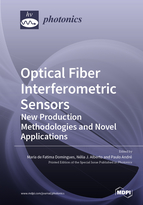Optical Fiber Interferometric Sensors: New Production Methodologies and Novel Applications
A special issue of Photonics (ISSN 2304-6732). This special issue belongs to the section "Lasers, Light Sources and Sensors".
Deadline for manuscript submissions: closed (31 May 2021) | Viewed by 34865
Special Issue Editors
Interests: study and simulation of optoelectronics components; fiber Bragg gratings; integrated optics in sol-gel substrates; passive optical networks; big data processing
Special Issues, Collections and Topics in MDPI journals
Interests: optical fiber sensors; fiber Bragg gratings; Fabry-Perot interferometers; fiber sensors applications; biosensing
Special Issues, Collections and Topics in MDPI journals
2. Instituto de Telecomunicações, Aveiro, Portugal
Interests: optical fiber sensors; fiber Bragg gratings; Fabry-Perot interformetric sensors; eHealth applications; gait analysis; wearable sensing devices
Special Issues, Collections and Topics in MDPI journals
Special Issue Information
Dear Colleagues,
Optical fiber interferometric sensors have been widely investigated for potential application in many situations, such as, for example, monitoring temperature, strain, pressure, and most recently, in the detection and characterization of different physical, chemical, and also physiological parameters.
This Special Issue will focus on current state-of-the-art research in optical fiber interferometric sensors, covering recent technological improvements, new production methodologies, and emerging applications.
Both original research papers and review articles describing current state-of-the-art innovations in this research field are welcome. We hope this SI will provide you an overview of the present status and future outlook of the aforementioned topics.
The manuscripts should cover, but are not limited to, the following topics:
- New and/or low-cost interferometers production methods
- Novel optical fibers and Fabry-Perot, Mach-Zehnder, Michelson, and Sagnac-based sensors
- Optical fiber interferometric based sensing for physical and chemical parameters
- Optical fiber interferometric systems with microfluid integration
- Low-cost, miniaturized, selective and multiparameter optical fiber interferometric devices
- New bio/chemical probes for biomedical applications
- Wearable/biomedical interferometric sensors
- Advanced signal processing techniques
- New interrogation techniques for interferometric sensors
Applications may include, but not limited to medical diagnostics and therapy instrumentation, structure health monitoring, chemical processing, metrology, aquaculture, oil and gas industry, robotics.
Dr. Maria de Fátima Domingues
Dr. Nélia J. Alberto
Prof. Paulo André
Guest Editors
Manuscript Submission Information
Manuscripts should be submitted online at www.mdpi.com by registering and logging in to this website. Once you are registered, click here to go to the submission form. Manuscripts can be submitted until the deadline. All submissions that pass pre-check are peer-reviewed. Accepted papers will be published continuously in the journal (as soon as accepted) and will be listed together on the special issue website. Research articles, review articles as well as short communications are invited. For planned papers, a title and short abstract (about 100 words) can be sent to the Editorial Office for announcement on this website.
Submitted manuscripts should not have been published previously, nor be under consideration for publication elsewhere (except conference proceedings papers). All manuscripts are thoroughly refereed through a single-blind peer-review process. A guide for authors and other relevant information for submission of manuscripts is available on the Instructions for Authors page. Photonics is an international peer-reviewed open access monthly journal published by MDPI.
Please visit the Instructions for Authors page before submitting a manuscript. The Article Processing Charge (APC) for publication in this open access journal is 2400 CHF (Swiss Francs). Submitted papers should be well formatted and use good English. Authors may use MDPI's English editing service prior to publication or during author revisions.








